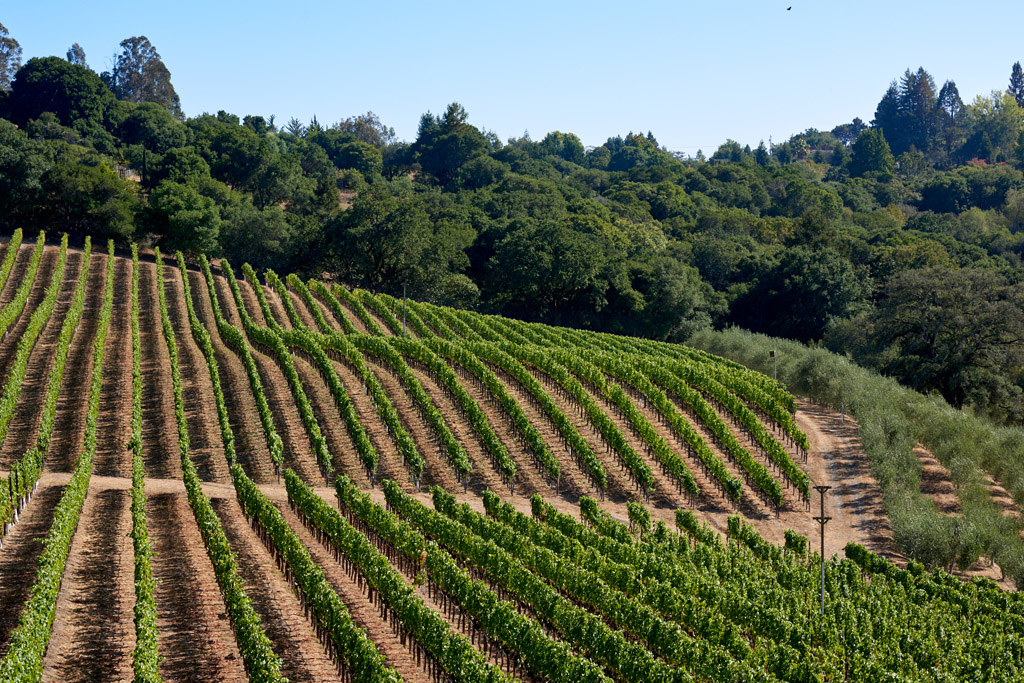Whither Côte-Rôtie
With these essays, my attention now turns to Côte-Rôtie, the esteemed Syrah zone in the northern Rhone Valley. I’m not a wine historian, nor do I suffer the delusion that we are producing Côte-Rôtie from our Estate vines; that only happens much closer to Ampuis than where Baker Lane is situated. These musings reflect on Côte-Rôtie as a platonic Syrah model, its inspirational impact, and some intriguing parallels that overlap our viticultural dreams.
To begin with, the name (which translates to ‘roasted slope’), is curiously both accurate and misleading. The sun does indeed bathe the appellation’s southeast facing vines throughout much of the summer day. Yet this northern part of the Rhone River Valley is climactically not much hotter overall than the manifestly cool vineyards in nearby Burgundy. The AOC’s codified allowance for blends that include up to 20% Viognier (which matures earlier than Syrah) is rooted as much in the idea of providing a ripeness boost to the Syrah as it is in augmenting the wines’ aromatic expression. In this respect, our success in cultivating it in Sebastopol’s cool Sonoma Coast region (i.e. one almost exclusively planted in Pinot Noir) echoes the Côte-Rôtie weather model. These days, more advanced viticultural practices employed by Côte-Rôtie winemakers allows most of them to eschew a Viognier inclusion. Their confidence is supported by the fact that Syrah (in the generally mild climate that pertains there) can easily be profoundly aromatic on its own. Although we planted Viognier at Singer Baker Lane Estate with the idea of adding its ineffable character to our Syrah wine, we too have gradually diverged from that practice. With our mild summer climate, Syrah’s tremendous capacity for profoundly aromatic expression has also proven to be deeply intrinsic to our site. A coda to that realization is that a stand-alone white wine made from our Viognier fruit is a sterling version of this exotic and hypnotic variety (a win/win, you might say).
Like many googley eyed enthusiasts, Burgundy was my first obsession. I was rapt in my exploration of maps of its vineyards which directed me to one ethereal taste after another. The pioneering boutique importer, Kermit Lynch, did much to focus my attention on the myriad distinguished vineyards of the Cote D’Or. As my wine obsession soon led to other of France’s viticultural treasures, my attention naturally drifted to the Rhone (as did Kermit’s as well, who succeeded brilliantly at championing this region’s virtues). While I found the wines perhaps less lacy and ethereal than the gems of Burgundy, the depth and explosive (trance inducing) nature of their aromatics were every bit as rewarding.
In reviewing the written history of the Côte-Rôtie, I was struck anew by some key facts. Aside from its minuscule total acreage (550 at present; by comparison, California alone has upwards of 15,000), it scarcely resonated with importers and collectors until well in to the 1980’s. As recently as 1970, a scant 225 acres were in vine, and the wines were mostly sold as vin ordinaire. My love affair with its wines began with the amazing late 1970’s bottlings that I was lucky to be able to afford upon release. Kermit, along with a few other far-sighted importers, was indispensable in making this possible. The point here is that, although the history of viticulture in this sector in the northern Rhone Valley extends back to the Romans, its current global recognition only spans a couple of generations. An analogous depth (or lack thereof) of history exists in western Sonoma county. Our current widespread practice of viticulture spans the last 35 years, and Syrah is even more of newcomer, entering the fold at the turn of the century. Our vineyard was, in effect, part of that advance guard. I elected to plant Syrah on Baker Lane not because there were nearby precedents to emulate, but rather to follow a passion for flavor. I knew that we were going to be unsparing in our efforts (and expense) to achieve distinction, but I’d be lying if I said I knew what that might look or taste like. More than anything else, given how Syrah has distinguished itself on Baker Lane, a situation emerged where it was better to be lucky (and stubborn) than smart.
The manner in which Syrah is uncommonly transparent of site (i.e wherein terroir is unimpeded in effecting flavor and character) is markedly in evidence with Côte-Rôtie. Its particular combination of exposure, soil and climate render wines of sumptuous depth and spice that diverge from the grip and structure that highlights the versions of Syrah from the celebrated proximate appellations of Hermitage and Cornas. That a grape can have so many distinct subtle iterations makes it extraordinarily useful for its most important application, that is as a companion to one delicious table or another.
Through 18 growing seasons on Baker Lane, we have gradually fashioned a clear understanding of our site’s character (as illustrated by our wine’s dark fruit depth and abundance of savory notes). Being able to fantasize a diverse array of enticing food combinations for our wines (i.e. one that compares favorably to the ample options great Côte-Rôtie suggests) is rewarding to say the least. While it does much to keep us hungry and thirsty, it also delights for how it connects us to the global canon of viticultural discovery. While it’s entirely possible that many of the potentially greatest vineyard sites in California have ended up as parking lots, it’s gratifying to imagine that others were allowed to shine (if only by luck and grit).

